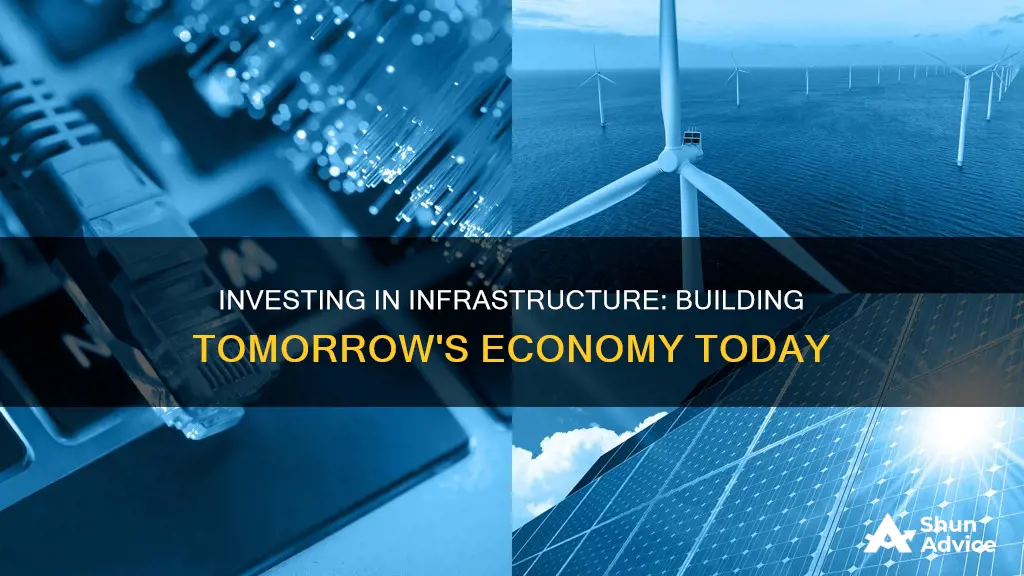
Investing in infrastructure funds is an appealing prospect for many investors due to the stability and consistency of returns it offers, even during turbulent economic periods. Infrastructure funds are considered safe investments because they are non-cyclical and have low variable costs, resulting in steady and predictable cash flows. The assets involved in infrastructure funds, such as bridges, roads, highways, and energy systems, are crucial to a country's development and will continue to be in high demand regardless of economic conditions. Additionally, infrastructure funds are diverse, spanning various sectors, strategies, and geographies, allowing investors to choose from a wide range of options with different risk-return profiles. The energy transition, digitalization, and government support further enhance the attractiveness of infrastructure funds, making them a compelling choice for investors seeking stable and long-term returns.
| Characteristics | Values |
|---|---|
| Appetite persists despite the macroeconomic environment | The private infrastructure market has more than tripled in size since the global financial crisis, with more than $550 billion raised by unlisted infrastructure funds over the past 10 years. |
| Diversity of strategies | Infrastructure funds span the entire risk-reward spectrum, ranging from core and core-plus with a lower risk-return profile to value-add, opportunistic, and even distressed infrastructure investing with a significantly greater potential for returns and corresponding risk. |
| ESG in the spotlight | Infrastructure is a natural fit for ESG investing, given the strong focus on the transition to cleaner energy among both specialist and generalist infrastructure funds. |
| Diversity of structures | Infrastructure strategies can be pursued via unlisted funds and listed funds with a variety of fund structures. |
| Appeal to high net worth and retail capital | Infrastructure strategies can be a good fit for individual investors that are beginning to invest in private markets. |
| The market for infrastructure secondaries is heating up | In the first half of 2023, approximately $2 billion to $4 billion of infrastructure secondaries transactions closed, with many more transactions targeting closing in the second half or early 2024. |
| Fund terms unique to infrastructure funds | Terms of infrastructure funds are generally similar to private equity with some differences, including economics, fund term, holding periods, and withdrawal/redemption rights. |
| Non-cyclical | Infrastructure offers stable and predictable cash flows. |
| Low variable costs | Infrastructure comes with extremely small marginal costs per use. |
What You'll Learn
- Infrastructure funds are a safe haven in the face of current macroeconomic challenges
- They are non-cyclical and offer stable and predictable cash flows
- They are real assets that are essential to a country's development
- They are riding the wave of secular mega-trends like the energy transition and digitisation
- They are a good fit for individual investors that are new to private markets

Infrastructure funds are a safe haven in the face of current macroeconomic challenges
The appeal of infrastructure funds lies in their countercyclical nature, non-correlation with the stock market, and perceived lower-risk profile. Infrastructure funds offer stable and predictable cash flows, as the assets often come with regulated and contracted revenue models. For example, a newly constructed sewage system could include a government contract to run for the next decade, ensuring predictable cash flows.
Additionally, infrastructure funds provide exposure to essential services such as energy provision, transportation, and utilities, which are crucial to a country's development. These sectors, including oil & gas midstream, waste management, airports, shipping & ports, and utilities, are expected to generate steady cash yields.
Furthermore, infrastructure is riding the wave of secular mega-trends, including the energy transition, digitalization, and unprecedented government support. The Bipartisan Infrastructure Law in the United States, for instance, directs $1.2 trillion towards transportation, energy, and climate infrastructure projects, most of which is distributed to states with the lowest-rated infrastructure.
In conclusion, infrastructure funds offer a compelling choice for investors due to their diversity of strategies, stable cash flows, essential service provision, and alignment with secular trends and government initiatives. These factors contribute to their perception as a safe haven during challenging macroeconomic periods.
Money Market Funds: Secure, Liquid, and Profitable Investments
You may want to see also

They are non-cyclical and offer stable and predictable cash flows
Investing in infrastructure is often appealing because it is non-cyclical and offers stable and predictable cash flows. This means that infrastructure assets are crucial to a country's development and will be heavily used regardless of the economic climate. For example, a newly-constructed sewage system could include a government contract to run for the next decade. Unless the government goes bankrupt (which is unlikely in developed markets), the cash flows are quite predictable.
In contrast, a small Italian restaurant at the corner of the street may go bankrupt during a long economic recession. This risk does not apply to infrastructure assets. Bridges and roads are essential to a country's development and will still be heavily used regardless of the state of the economy.
Infrastructure debt is also appealing because it offers exposure to investments that provide essential services and have high barriers to entry, resulting in long-term stable cash flows that are relatively immune to the macroeconomic environment. Infrastructure debt borrowers have demonstrated lower historical losses than equivalently rated companies.
Infrastructure assets can also have extremely small marginal costs per use, which is completely negligible. For example, using a bridge, every car that drives on it will bring extremely small variable costs.
Overall, infrastructure investments are often seen as a safe port in the face of current macroeconomic challenges.
Vanguard Funds: Investing in the Future with FAANG
You may want to see also

They are real assets that are essential to a country's development
Infrastructure funds are a form of "real assets", which contain physical assets seen in everyday life. These include bridges, roads, highways, sewage systems, and energy. These assets are crucial to a country's development and are therefore heavily used, regardless of the economic climate.
Infrastructure assets provide stable and predictable cash flows. For example, a newly constructed sewage system could include a government contract to run for the next decade. Unless the government goes bankrupt (which is unlikely in developed markets), the cash flows are predictable. This is in contrast to a small business, which may go bankrupt during a long economic recession.
Infrastructure assets also have extremely small marginal costs per use. For example, the variable costs of each car that drives over a bridge are extremely small.
Infrastructure assets can be categorised as:
- Greenfield (early-stage): The developers have decided to carry out the project, but only very basic plans have been made. These projects face the largest amount of risk, mainly in construction, regulation, and execution.
- Greenfield (late-stage): The developers are further along than the early stage. Plans have already been developed, and everything is confirmed with various stakeholders. The risk here is lower than in the early stage, but there is still construction risk and the possibility of CAPEX overruns.
- Brownfield assets: These are assets that are already operating and generating revenue, such as a completed bridge with cars running on it. This type of asset is the least risky because it usually has an established revenue stream.
In addition, infrastructure assets are non-cyclical, meaning they are not exposed to volatile commodity price markets or demand uncertainties. They are also downside-protected, meaning they will perform well irrespective of the economic cycle.
Infrastructure funds span many sectors, including oil & gas midstream, waste management, airports, integrated shipping, railroads, shipping & ports, trucking, engineering & construction, infrastructure operations, and the utilities sector.
Overall, infrastructure funds are a compelling choice for investors due to their diversity, stable cash flows, and essential role in a country's development.
Best Index Funds: Where to Invest Your Money
You may want to see also

They are riding the wave of secular mega-trends like the energy transition and digitisation
Investing in infrastructure funds is a compelling choice for several reasons. One of the key reasons is that infrastructure is riding the wave of secular mega-trends like the energy transition and digitisation. Here's a more detailed look at how these trends are shaping the attractiveness of infrastructure funds:
Energy Transition
The global shift towards renewable and sustainable energy sources is a significant mega-trend. This transition involves moving away from fossil fuels and embracing cleaner alternatives, such as wind, solar, and hydroelectric power. This shift has been accelerated by government initiatives, such as the Bipartisan Infrastructure Law in the United States, which allocates federal funds towards energy infrastructure projects, and the Inflation Reduction Act, which provides additional support for the energy transition.
The energy transition creates numerous investment opportunities in renewable energy infrastructure, such as wind farms, solar panel installations, and battery storage solutions. These investments are seen as relatively safe because they often involve long-term government contracts, ensuring predictable cash flows. Additionally, the inherent nature of infrastructure assets, such as bridges and roads, means they are crucial to a country's development and will continue to be heavily used regardless of economic conditions.
Digitisation
Digitisation is another mega-trend that is transforming the energy sector and society as a whole. Digital technologies, including information and communication technologies (ICT), modern sensors, big data, artificial intelligence, and the internet of things, are being integrated across the energy value chain. This transformation improves the way we use energy, making energy systems more connected, intelligent, efficient, reliable, and sustainable.
The digitisation of the energy system enables better management and distribution of energy resources, facilitates the integration of renewable energy sources, and enhances energy efficiency. For example, smart grids, smart meters, and smart homes enable consumers to have greater control over their energy use and bills. Additionally, digital technologies improve energy security and resilience, particularly with the strengthening of cybersecurity measures in energy networks.
The combination of the energy transition and digitisation mega-trends creates a favourable environment for infrastructure funds. These trends open up diverse investment opportunities, from renewable energy projects to digital infrastructure and data centres. The inherent characteristics of infrastructure assets, along with government support and the integration of new technologies, make infrastructure funds an attractive proposition for investors seeking stable and long-term returns.
Hedge Funds: Higher Returns, Lower Risk than Mutual Funds
You may want to see also

They are a good fit for individual investors that are new to private markets
Investing in infrastructure funds can be a good fit for individual investors that are new to private markets. Infrastructure funds are a compelling choice because they are a safe port in the face of current macroeconomic challenges. Since the global financial crisis, the private infrastructure market has more than tripled in size, with more than $550 billion raised by unlisted infrastructure funds over the past 10 years.
Infrastructure funds are a diverse asset class, spanning many sectors, strategies, and geographies. They can be a good fit for individual investors because they present the potential for consistent returns. They are also more easily understood by investors new to private markets. There is an intrinsic appeal to investing in "real assets" such as utilities, transportation hubs, and roadways that are highly valued in society and essential to daily life.
The compelling narrative, when combined with stable returns and the greater liquidity of an open-ended fund structure, can be very attractive to high-net-worth and retail investors. This is a fact that is not lost on private fund sponsors (GPs) that have set their sights on the relatively untapped retail market.
In addition, infrastructure funds can be a good fit for individual investors because they are non-cyclical and offer stable and predictable cash flows. For example, a newly constructed sewage system could include a government contract to run for the next decade. So, unless the government goes bankrupt (a slim chance in developed markets), the cash flows are quite predictable.
Overall, infrastructure funds can provide individual investors with a good opportunity to dip their toes into private markets due to their stable returns, intrinsic appeal, and predictable cash flows.
Mutual Funds: Investing in Government Treasury
You may want to see also
Frequently asked questions
Infrastructure funds are a form of "real assets", which contain physical assets we see in everyday life like bridges, roads, highways, sewage systems, or energy. Such types of assets are quite crucial in a country's development and offer stable and predictable cash flows.
While infrastructure assets are crucial to a country's development and will be heavily used regardless of the economic cycle, there are still risks involved. Leverage, or the amount of debt taken on, is common in infrastructure investments and can pose a risk if revenue-generating abilities are not enough to match the interest. There are also ESG (environmental, social, and governance) risks to consider, as well as political factors that can impact the development and regulation of infrastructure.
Infrastructure funds offer investors low-maintenance investments with predictable risk profiles and strong, consistent returns, even through chaotic periods. They are also non-cyclical, meaning they are not correlated with the stock market and have a lower risk profile. Infrastructure funds can provide diversification, income, and consistent returns.
Some examples of infrastructure funds include the Lazard Global Listed Infrastructure Port, Nuveen Global Infrastructure Fund, and abrdn Global Infrastructure Fund.







